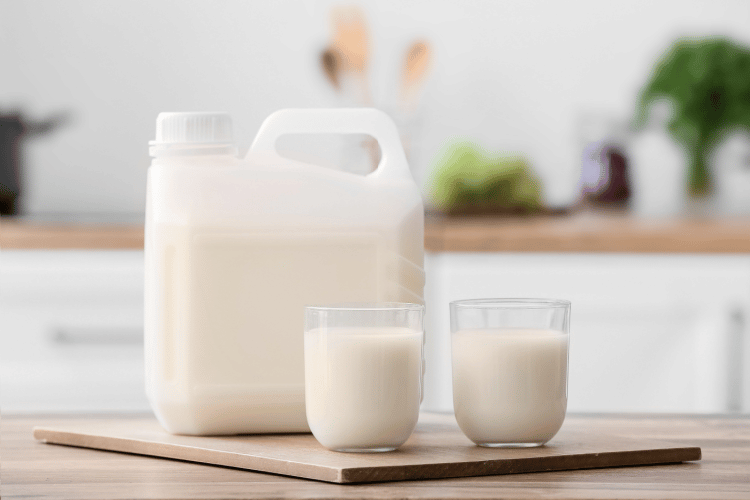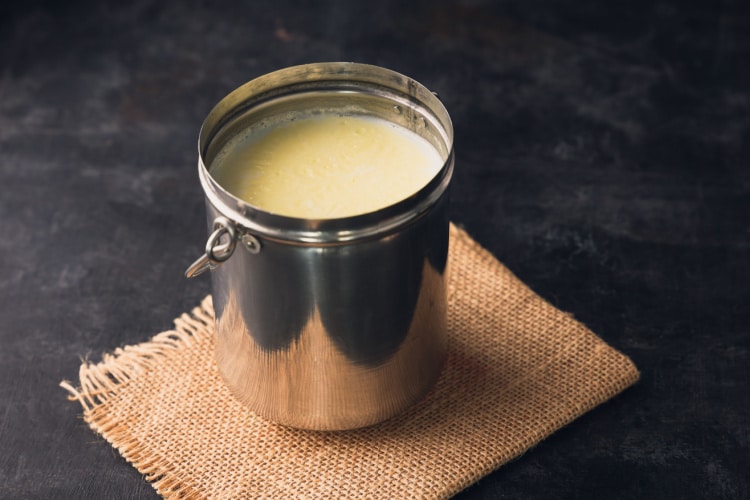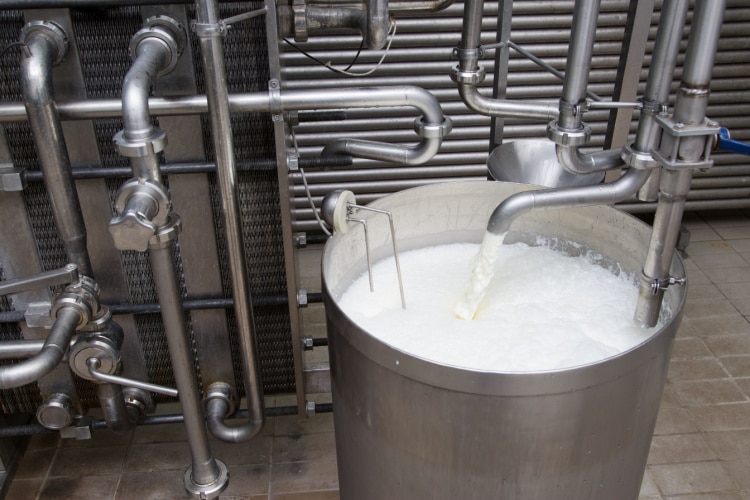When you go to the grocery to buy milk, you have a confusing array of options — raw, whole, skim, homogenized, pasteurized milk — what do they all mean, and why do they come in different color packaging?
In this article, we’ll discuss these milk varieties, focusing on whole milk vs. homogenized milk. It’s actually interesting, so don’t go anywhere yet!
Difference Between Whole Milk and Homogenized Milk
Whole milk is actually a type of homogenized milk that has the maximum level of fat. This means that homogenized milk can be found in a range of fat content varieties, including whole (3.25% fat), reduced (2% fat), low (1% fat), and skim milk (0 – 0.5% fat).

See, all milk is generally the same: 87% water, about 8.25% solids, and 0 – 5% fat. Fat, as you may have guessed, explains the different types of milk and their different color packaging.
The milk fat in natural milk has a tendency to rise to the surface and produce a coating of cream. Milk enthusiasts that prefer this raw or “non-homogenized” milk need to shake the liquid container to dissolve that layer of cream before consuming.
This is where homogenized milk comes in handy — to avoid re-mixing the cream into the milk before drinking it.
Homogenization is the process where the creamy part of milk is broken down under pressure and distributed evenly throughout so it has a smooth and even consistency.

To achieve that, the milk is heated, stirred, and forced through a valve at high pressure. Through this, the fat molecules are altered to match the size and density of the remainder of the milk.
This dairy hack prevents the cream from rising to the surface, makes for a silky and uniform consistency, and has no influence on the flavor or composition of the milk.
Types of Homogenized Milk
Humans have been drinking milk for thousands of years, but unlike in the past, when people only drank the purest form of milk with a fat level of about 4%, today, the process of homogenization has made it possible for us to pick how much fat we want in a glass of milk, smoothie, cereal, coffee, etc.
The four main varieties of milk you may get when shopping in the dairy aisle are:
- Whole milk (3.25%)
- Reduced fat (2%)
- Low-fat (1%)
- Fat-free or skim milk (0-0.5%)
These percentages are mentioned on the box and via the various bottle colors. Whole milk is typically packaged or capped in red, reduced fat comes in blue, low-fat in green, and skim milk in purple.
Why the Difference in Fat?
Towards the end of the 1970s in America, an increasing number of people started to struggle with obesity and heart problems. This occurrence was linked to diets that were high in saturated fat and cholesterol, including high-fat milk.
As a result, there were campaigns to help people reduce fat within their diet and, along with that, the food industry started manipulating foods to reduce the fat content within those products to help people lose weight — which is where the lower fat levels of milk came into play.
Nutritional Content Breakdown: Which One Is Healthier?
Reduced, low-fat, and skim milk have fewer calories and more vitamins per cup than full milk. They also have lower saturated fat content, which has been associated in research with higher levels of “bad” cholesterol and a higher risk of heart disease.
However, one of the primary problems with lowering milk’s fat level is that producers are essentially taking something pure, natural, and organic and turning it into something that is a little more processed and artificial. As a result, manufacturers are not only removing the fat but also some of the natural nutrients present in the milk.
Although the nutritional table below shows greater levels of vitamins and minerals in low-fat milk varieties, they are synthetic and included after processing. Even worse, skim milk and reduced-fat milk frequently have more added sugar than whole milk.
Thus, it’s much preferable to limit the number of macronutrients ingested throughout the day than switch to low-fat milk, especially the number of saturated fats. Instead of consuming twice as much skim milk just because it contains less fat, make sure you consume less whole milk.
Nutritional Profile of Homogenized Milk Varieties
| Category (1cup) | Whole Milk | Reduced-Fat Milk | Low-Fat Milk | Non-Fat Milk |
| Calories | 146 | 122 | 102 | 86 |
| Carbs | 11.03g | 11.42g | 12.18g | 11.88g |
| Fat | 7.93 | 4.81g | 2.37g | 0.44g |
| Saturated fat | 4.551g | 3.067g | 1.545g | 0.287g |
| Cholesterol | 24mg | 20mg | 12mg | 5mg |
| Sodium | 98mg | 100mg | 107mg | 127mg |
| Potassium | 349mg | 366mg | 366mg | 407mg |
| Protein | 7.86g | 8.05g | 8.22g | 8.35g |
| Fiber | 0g | 0g | 0g | 0g |
| Sugars | 12.83g | 12.35g | 12.69g | 12.47g |
| Vitamins & Minerals | ||||
| Vitamin A | 86mcg | 134mcg | 142mcg | 5mcg |
| Calcium | 276mg | 285mg | 290mg | 301mg |
| Iron | 0.07mg | 0.07mg | 0.07mg | 0.1mg |
What Does Fat Do in Recipes?
Fat makes baked products flakier and more tender by preventing gluten development. When there is a bit more fat in cakes and muffins, the crumb is usually softer and the texture is less dry.
Not only baked goods but ice cream, mayonnaise, and whipped cream all have creamy textures because of this. Fat is also a flavor absorber, which is why we use oils to infuse the flavor of herbs and spices into food. Emulsification is another of its uses! Soups, stews, mashed potatoes, or sauces like teriyaki wouldn’t cling together without the fats.
Can Different Milk Fat Alter a Recipe in Any Way?
What happens if the recipe asks for whole milk, but all you have is 2%? Don’t worry, you can still try your desired recipe.
But, if you don’t add enough butter or another emulsifier to, let’s say, a creamy tomato soup that’s made with skim milk, the texture could separate and affect the flavor.
If you want to replace whole with milk that’s lower in fat in baked recipes or sauces, substitute them at a 1:1 ratio and add enough butter to make up for the loss of fat — roughly 2 tablespoons of butter per 1 cup of milk.
What About Pasteurized Milk?

If you’ve ever really looked at a milk carton or milk bottle, you might have seen the word pasteurized milk on the label. So why does milk need to be pasteurized?
Pasteurization is a heat-based procedure that removes potentially hazardous bacteria from milk while retaining all of the vitamins, minerals, and nutrients that make milk such a healthy option. Thanks to pasteurization, that healthy, nutritious milk you bought at the store can stay fresh longer.
There’s another type of pasteurization called ultra-high temperature pasteurization or UHT that takes all of this a step further. UHT is what we call shelf-stable, meaning the milk can stay fresh on the shelf unopened for several months.
UHT pasteurized milk is a great choice if you’re going camping or hiking or simply want to store some milk at home when you don’t have room in your fridge.
Conclusion
I hope the universe of milk fats is much clearer to you now!
To sum up, if you leave raw milk alone for a while, the cream will always rise to the top! So homogenization is the process where that creamy part is broken down under pressure and distributed evenly throughout the milk, so it has a smooth and even consistency.
Whole milk contains the most fat of any homogenized milk. Reduced-fat milk is next in line, then low-fat, and in last place, skim milk! When it comes to nutrition, we recommend sticking to whole milk (in moderate amounts) because it contains more natural nutrients! More fatty milk also results in creamier sauces and luscious, soft-baked items!
Now that’s all cleared up; we’ll let you get back to something else that’s good — a freshly poured glass of cold, delicious, pasteurized, and homogenized milk!







